|
Quadricentennial Challenge Catskills Live! Trails & Wilderness Association issues a challenge to all — venture forth and seek all 15 Quadricentennial Challenge geocaches. Go to many great places throughout Ulster County — visit the shores of the Hudson, feel the cool air in an historic cement mine, enjoy our small parks, ride on our rail trails, summit two Catskill peaks, and savor the breath-taking view from Gertrude's Nose in Minnewaska State Park Preserve. Bask in our county's treasures with family and friends, exercise your body, and build lasting memories. Specially minted commemorative Quadricentennial geocoins are being released from Challenge geocaches in celebration of the 400th anniversary of the exploration of New York State by Henry Hudson. All 15 Challenge caches will be available this summer. Funding for the Challenge was provided by Ulster County and the Hudson River Valley Greenway. Historic Cement Mines and Mining
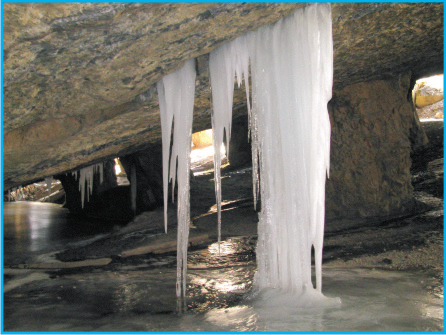 The Rosendale region maintained its competitive edge because of its ready market transportation access via the Delaware and Hudson Canal, the Rondout Creek, and the Hudson River. The natural cement was used in many well-known landmarks, including the U.S. Capitol building, the Brooklyn Bridge, the pedestal of the Statue of Liberty, the Washington Monument, and the Delaware and Hudson Canal. Production of the natural cement required a labor-intensive refining process involving firing in kilns, cracking, and grinding prior to packaging in cement powder-filled 300-pound wooden barrels.
The Rosendale region maintained its competitive edge because of its ready market transportation access via the Delaware and Hudson Canal, the Rondout Creek, and the Hudson River. The natural cement was used in many well-known landmarks, including the U.S. Capitol building, the Brooklyn Bridge, the pedestal of the Statue of Liberty, the Washington Monument, and the Delaware and Hudson Canal. Production of the natural cement required a labor-intensive refining process involving firing in kilns, cracking, and grinding prior to packaging in cement powder-filled 300-pound wooden barrels.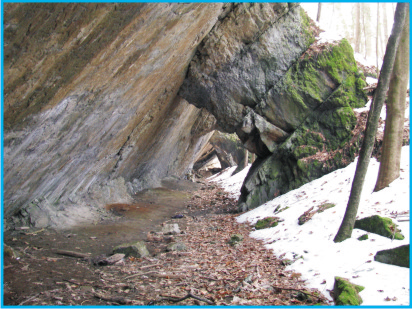 Miners excavated two narrow (10 to 26 foot thick) members of the Rondout Formation, faithfully following them along complexly folded and faulted bedrock layers — often deeply below the water table. Today we see the results of their efforts in mines that are nearly level, at shallow and steep angles, vertical, and even stacked one on top of another.
Miners excavated two narrow (10 to 26 foot thick) members of the Rondout Formation, faithfully following them along complexly folded and faulted bedrock layers — often deeply below the water table. Today we see the results of their efforts in mines that are nearly level, at shallow and steep angles, vertical, and even stacked one on top of another.
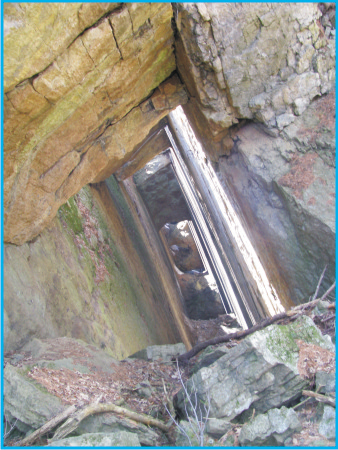 As they removed the bedrock using sledgehammers, star drills, black powder, and much later pneumatic drills, they would essentially create large rooms. For safety, they left large pillars to support the overlying bedrock ceiling or adjacent wall rock. Thus, these mines are referred to as room-and-pillar mines.
As they removed the bedrock using sledgehammers, star drills, black powder, and much later pneumatic drills, they would essentially create large rooms. For safety, they left large pillars to support the overlying bedrock ceiling or adjacent wall rock. Thus, these mines are referred to as room-and-pillar mines.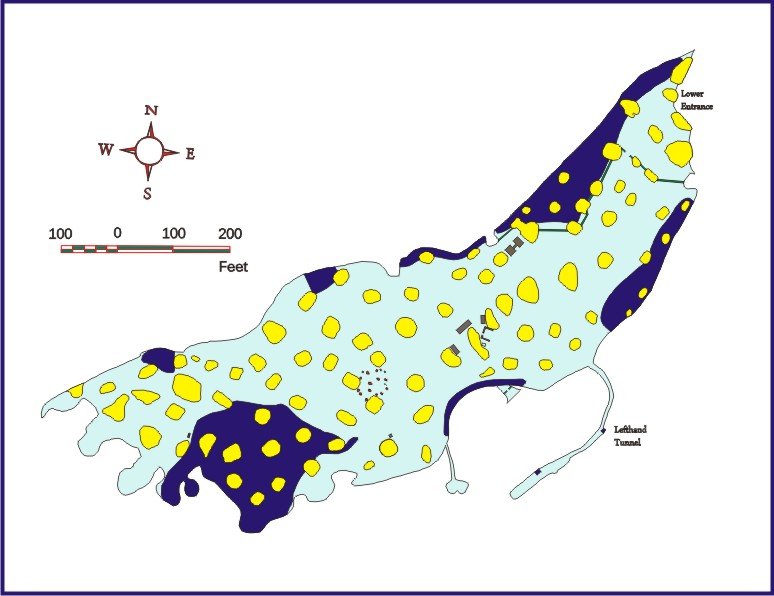 The accompanying map depicts a local room-and-pillar mine with its numerous support columns.
The accompanying map depicts a local room-and-pillar mine with its numerous support columns. Once groundwater was encountered, pumps were run around the clock to allow mining to continue. Interestingly, trained expert cave divers have penetrated to depths greater than 300 feet in a vertically-bedded Kingston cement mine — a depth far below the level of the Hudson River. Divers observed old company offices and artifacts deep underwater, standing in quiet testimony of bygone glory days.
Once groundwater was encountered, pumps were run around the clock to allow mining to continue. Interestingly, trained expert cave divers have penetrated to depths greater than 300 feet in a vertically-bedded Kingston cement mine — a depth far below the level of the Hudson River. Divers observed old company offices and artifacts deep underwater, standing in quiet testimony of bygone glory days.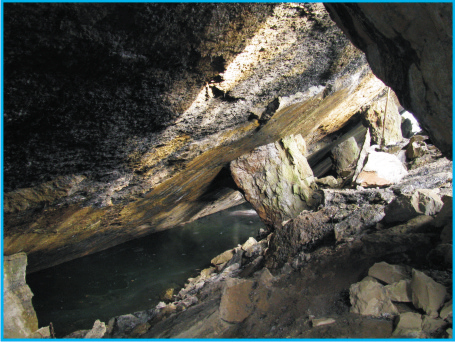 Since then, mines have been used for mushroom and trout farms, bomb shelters, records storage, water supply, and at the Widow Jane Mine - for special events. Today, water-filled portions of many of these mines represent vast untapped reservoirs.
Since then, mines have been used for mushroom and trout farms, bomb shelters, records storage, water supply, and at the Widow Jane Mine - for special events. Today, water-filled portions of many of these mines represent vast untapped reservoirs.The Widow Jane Mine
The Century House Historical Society Museum and Archives The museum and collections of the Century House Historical Society at this cache site are dedicated to the industrial history of the Rosendale natural cement region. They provide a resource visited and used by scholars worldwide. The Snyder Estate Museum is open to the public from May to October on Wednesday, Saturday and Sunday from 1:00 pm to 4:00 pm or by appointment (see http://www.centuryhouse.org/). During your visit, be sure to view the special Hudson-Fulton Exhibit and the1909 Tricentennial commemorative coin in the museum. The Cache, Site Access and the Widow Jane Mine 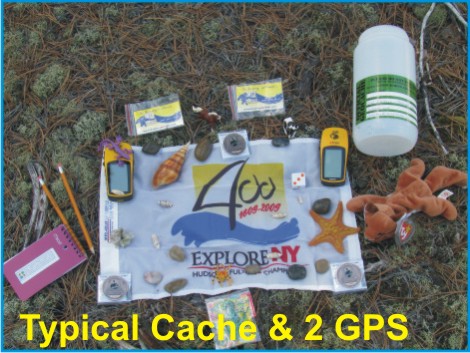 Access to the cache is through the lovely, groomed, Snyder Estate off Rt. 213 in Rosendale, New York. Proceed past the Museum House, alongside a pond, and up to the Widow Jane Mine. The cache is a 2-liter cylindrical poly bottle hidden outside the mine where access does not necessitate damaging vegetation. The cache is filled with kid-friendly items and, initially, three NYS Quadricentennial Challenge geocoins designed to travel throughout the world. This geocache was approved by The Century House Historical Society.
Access to the cache is through the lovely, groomed, Snyder Estate off Rt. 213 in Rosendale, New York. Proceed past the Museum House, alongside a pond, and up to the Widow Jane Mine. The cache is a 2-liter cylindrical poly bottle hidden outside the mine where access does not necessitate damaging vegetation. The cache is filled with kid-friendly items and, initially, three NYS Quadricentennial Challenge geocoins designed to travel throughout the world. This geocache was approved by The Century House Historical Society.This geocache is available throughout the week from dawn to dusk. After finding the geocache, be sure to take a look inside the Widow Jane Mine. While the entry area is safe and is easily seen with natural lighting, be sure to bring a flashlight if you wish to look more closely at the mine, its pillars, and the underground lake. Please respect this private property, thus keeping it open for others. Thank you. Should you see Dietrich Warner or Gayle Grunwald of the Century House Historical Society be sure to thank them for making the Snyder Estate property, the Widow Jane Mine, and the nature trail available for visitation. Parking An unpaved parking area is located near the Century House Historical Society Museum at the coordinates listed below. Please do not drive any further than this parking lot. From the parking area, proceed along established mown pathways toward the cache coordinates listed. No bushwhacking is required. Please Cache In and Trash Out! |
 With Henry Hudson's opening of what is now New York State to commercial ventures, one of the major industries that developed was that of cement manufacture. Early entrepreneurs hired laborers to mine Upper Silurian Rondout Formation dolostones and fossiliferous limestones from the earth. This rock unit is largely comprised of the shells of calcareous organisms that lived in a shallow, warm-water, ocean some 400 million years ago. This Rosendale bedrock came to be recognized as the highest quality natural cement in North America. It was known as an hydraulic cement because it hardened well under water. The cement industry was founded in 1819 in central New York, but soon shifted to the Rosendale-Kingston region in 1827, where it flourished for over 150 years — during much of that time the region was known as the "Cement Capitol" of the world. Natural cement production peaked in 1899 with an estimated annual production of almost ten million barrels of cement. Records of the Century House Historical Society document that the Century Cement Plant in Rosendale was the last cement works to manufacture natural cement in North America.
With Henry Hudson's opening of what is now New York State to commercial ventures, one of the major industries that developed was that of cement manufacture. Early entrepreneurs hired laborers to mine Upper Silurian Rondout Formation dolostones and fossiliferous limestones from the earth. This rock unit is largely comprised of the shells of calcareous organisms that lived in a shallow, warm-water, ocean some 400 million years ago. This Rosendale bedrock came to be recognized as the highest quality natural cement in North America. It was known as an hydraulic cement because it hardened well under water. The cement industry was founded in 1819 in central New York, but soon shifted to the Rosendale-Kingston region in 1827, where it flourished for over 150 years — during much of that time the region was known as the "Cement Capitol" of the world. Natural cement production peaked in 1899 with an estimated annual production of almost ten million barrels of cement. Records of the Century House Historical Society document that the Century Cement Plant in Rosendale was the last cement works to manufacture natural cement in North America.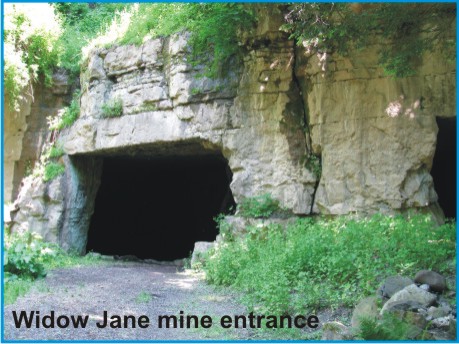 The Widow Jane Mine on the Snyder Estate in Rosendale, New York is a shining and safe example of the many room-and-pillar mines present throughout the Rosendale-Kingston region. It was mined along gently sloping geologic beds. The underground lake in it is fed by a combination of a nearby surface stream that sinks into its bed, groundwater, and water infiltrating through fractures in the ceiling. It is the only historic cement mine in Ulster County open to the public.
The Widow Jane Mine on the Snyder Estate in Rosendale, New York is a shining and safe example of the many room-and-pillar mines present throughout the Rosendale-Kingston region. It was mined along gently sloping geologic beds. The underground lake in it is fed by a combination of a nearby surface stream that sinks into its bed, groundwater, and water infiltrating through fractures in the ceiling. It is the only historic cement mine in Ulster County open to the public.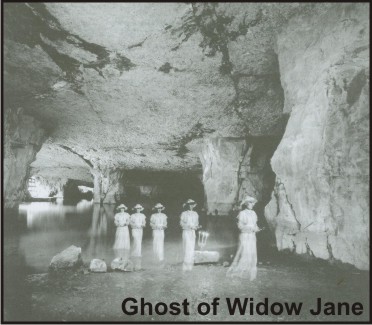 If the ghosts of mines past could tell tales, they would whisper of hardworking men toiling day after day to feed their families. They would long for the steady hammering of strong men breaking rock. They would relax now that the unending whine of pumps striving to keep groundwater from flooding the mines is no more. They would tell of the challenges of breaking resistant rock by hand and of the turf battles between different mining companies — of intentionally broken pumps, of lawsuits, and physical encounters. On a more subtle note, the ghosts might even reveal their features, rising out of the underground lake — like the ghost of Widow Jane caught in this by photograph by Will Faller.
If the ghosts of mines past could tell tales, they would whisper of hardworking men toiling day after day to feed their families. They would long for the steady hammering of strong men breaking rock. They would relax now that the unending whine of pumps striving to keep groundwater from flooding the mines is no more. They would tell of the challenges of breaking resistant rock by hand and of the turf battles between different mining companies — of intentionally broken pumps, of lawsuits, and physical encounters. On a more subtle note, the ghosts might even reveal their features, rising out of the underground lake — like the ghost of Widow Jane caught in this by photograph by Will Faller.